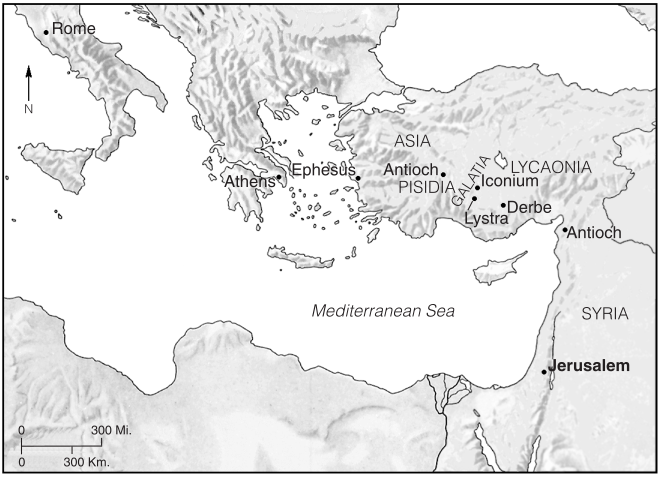Open Bible Data Home About News OET Key
A B C D E F G H I J K L M N O P Q R S T U V W XY Z
Tyndale Open Bible Dictionary
Intro ← Index → ©
GALATIA
Ancient kingdom resulting from migrations of Gallic people from the west and settlement on the central plain of Asia Minor. An earlier migratory movement resulted in the sack of Rome by the Gauls (or Celts) in 390 BC, but in a later attempt to overrun Greece the Gallic invaders were repulsed. That unsuccessful invasion into Greece led the Gauls to turn their attention to Asia Minor. They penetrated the larger part of the area but were defeated by Attalus I in 230 BC. As a result, they became restricted to that part of Asia later known as Galatia. By that time, the Gauls consisted of three tribes, the Trocmi, Tolistobogii, and Tectosages, which settled into the towns of Tavium, Pessinus, and Ancyra, respectively. In 189 BC these Galatians were subdued by the Romans but were allowed to govern themselves.
After the death of Amyntas in 25 BC, Galatia became a Roman province. Within its boundaries were the ethnic areas of Galatia proper, Lycaonia, Isauria, and parts of Phrygia and Pisidia. The new province, therefore, included the towns of Derbe, Lystra, Iconium, and Pisidian Antioch, all of which the apostle Paul visited on his first missionary journey. The term “Galatia” was used in two different ways, one to describe the area occupied by the Gauls in the north, and the other to describe the whole Roman province, including the southern towns. That ambiguity has given rise to a problem over the destination of Paul’s letter to the Galatians.
The original inhabitants of north Galatia were Phrygians, many of whom still remained in the first century AD, together with some Greeks and a fairly large community of Jews. Although the area was cosmopolitan, the Celtic element predominated. These people were known for their sturdy independence as well as for their drunkenness and revelings. In religious matters there is evidence that they were highly superstitious and were especially attracted to the wild rites of the goddess Cybele.
In towns of the southern region, Greek influence was more pronounced, especially among the more educated members of the communities. But the Phrygian element was still strong among the humbler inhabitants. They, too, were predominately devotees of Cybele, although there the cult had become modified by Greek influences. In Pisidian Antioch, for instance, the goddess was known as the Genius of Antioch, while in Iconium she was known as Athena Polias.
Geographically the northern towns, situated on a well-watered plateau and served by a major road from the Aegean shores to the west, became prosperous centers of commerce. But access from north to south was difficult and communication poor because of the mountainous terrain leading up to the plateau. The southern towns were situated on the route between Syria and Asia. Their strategic location explains why churches were established in those towns on Paul’s first missionary journey (cf. Acts 13–14).
Galatia, linked with Phrygia, is mentioned in Acts 16:6 and 18:23, but it is not clear whether Paul ever visited or established churches in the northern area. The only other references to Galatia in the NT are probably to the southern towns (1 Cor 16:1; 2 Tm 4:10; 1 Pt 1:1). See Galatians, Letter to the.

Galatia and the Surrounding Regions
Paul and Barnabas, thrown out of Antioch in Pisidia, descended the mountains, going east into Lycaonia. They went first to Iconium, a commercial center on the road between Asia and Syria. After preaching there, they had to flee to Lystra, 25 miles (40.2 kilometers) south. Paul was stoned in Lystra, but he and Barnabas traveled the 50 miles (80.4 kilometers) to Derbe, a border town. The pair then boldly retraced their steps.
